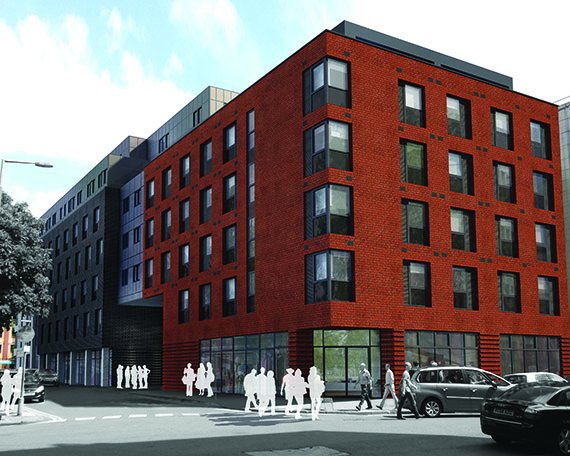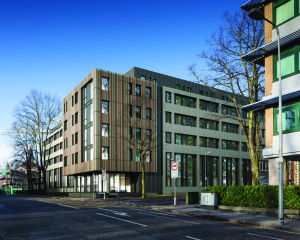
After a long drought, Cardiff is finally welcoming the return of office development, with spades in the ground to deliver a raft of new grade-A space.
The new development is clustered around the city’s railway station. JR Smart is on site building 85,000 sq ft of offices at No 2 Capital Quarter, a scheme due for completion in early 2016. Nearby, work is also underway on phase one of Rightacres’ 140,000 sq ft 1 Central Square, and the Welsh government has won planning consent to deliver a further 90,000 sq ft of new offices at Callaghan Square.
Yet, while Cardiff celebrates the imminent arrival of these new buildings, there is just as much activity being generated by the redevelopment of its old ones.
“The challenge is that as new space is delivered, we have to consider what we do with a large supply of secondary and tertiary accommodation,” says the city of Cardiff council’s head of economic development, Ken Poole.
He adds: “Some of it has a future as office space, but a lot is outdated and so we are open-minded about the potential of buildings being converted for alternative use.”
Unlike in England, there is no assumed consent in Wales to convert offices to residential and Poole insists decisions are made on a case-by-case basis. Yet Cardiff planners have proved broadly sympathetic to developers willing to give old office stock a new lease of life.
Student surge
So far that appetite has largely come from those delivering student accommodation. Cardiff is home to three universities and a host of other higher education institutions. Students already account for around 20% of the city’s population and there is a significant shortage of managed accommodation.
“We have seen a tremendous surge in demand for student accommodation over the last five years and developers have delivered a number of schemes, including the conversion of existing office space,” says Gareth Carter, director of development services at Savills.
Carter claims that with only 15,000 managed student bed places currently available in the city, there is plenty of scope for growth and estimates Cardiff has 3,500 student bed spaces currently under construction or with planning consent.
According to Knight Frank, around 40% of student accommodation schemes delivered by the private sector involve office conversions. Recent examples include Mansion Group’s conversion of the former Cardiff Institute for the Blind building on Newport Road into 200 student flats and London and Cornwall’s redevelopment of Summit House at Windsor Place into an 87-bedroom scheme.
While some developers have chosen to convert existing office buildings, others have opted to knock them down and start again.
Fusion Students has demolished the 50,000 sq ft former office building Windsor House to create a 322-bed scheme and is also knocking down Cardiff Metropolitan University’s former School of Art & Design at Howard Gardens to create a 200,000 sq ft student housing development.
“The market isn’t showing any sign of slowing and student numbers just keep going up,” says Knight Frank student property partner, Rachel Candelaria.
Student rooms were attracting £140 a week three years ago and that has risen to over £300. As a consequence, those developing student accommodation generally have the deepest pockets when it comes to bidding for old office stock.
When Fitzalan Court, a collection of office buildings off Newport Road, came to the market last year it attracted considerable interest. “There were a whole host of bidders, including those keen on office refurbishment,” says Candelaria, “but the student guys just blew them away.”

Rent revitalisation
The same is true right across the city. Owen Young, head of Alder King’s Cardiff office, is disposing of the 53,000 sq ft office Caradog House in Cathays Park. He says: “A joint venture between developer Crown and US bank WP Carey has exchanged contracts and hopes to convert it into a 378-bed student scheme.”
DTZ estimates that up to 300,000 sq ft of Cardiff’s office stock has been lost to alternative use over the last couple of years. Yet most office agents believe it is generally having a positive impact on the market.
“Most of these buildings are no longer fit for purpose,” says DTZ’s Rhys James. “They don’t meet the needs of modern occupiers. Most are located to the north or east of the city, an area many occupiers are vacating to move to the new business centre around Callaghan Square.”
According to JLL, there is still 900,000 sq ft of offices available in Cardiff. With new grade A stock coming on line and average annual take-up of around 460,000 sq ft, there is scope for further conversions.
Rhydian Morris, director in JLL’s Cardiff office, says: “Removing compromised space is good for the market because it allows everyone to focus on buildings which can meet occupier needs. Reducing supply will also encourage rental growth, which is what Cardiff really needs.”
Cardiff currently languishes near the bottom of the regional office rent rankings, with prime rentals at just £22 per sq ft. Agents are encouraged by a steady increase in rents achieved for decent grade B space now that availability is falling and JLL predicts grade A rents will also start to increase by around £1 per sq ft per year.
“But we have to be wary of buildings which could suit office occupiers being taken out of the market,” warns Savills’ office agency director, Gary Carver. “Not all occupiers want new grade A offices.”
Carver claims some buildings converted to student accommodation, such as Fitzalan Court and Custom House, close to Cardiff station, could have worked as office schemes.
Solicitor Blake Morgan is moving to new grade-A space at Central Square and its former 30,000 sq ft home at Bradley Court is currently on the market. Most agents believe it will end up being turned into student accommodation.
Conversion conundrum
There is now greater appetite for office refurbishments. Ardstone Capital recently fought off competition to purchase the Plas Glyndwr building opposite Cardiff Castle. Renamed 2 Kingsway, the building is to undergo a 40,000 sq ft grade A office refurbishment. As market conditions improve, others may follow suit.
The council is also hoping more developers will step forward to convert old office stock into others types of residential development.
Population growth forecasts suggest the city will need an extra 45,000 homes by 2026, some of which could be provided by the conversion of redundant office stock.
“But there have been no office to pure residential conversions in the city centre since the crash,” says Savills’ Carter. “There may be more demand for city living now the BBC has committed to Cardiff, but most will have to be new-build, as there aren’t many buildings suitable or in the right location for conversion.”
Hope for new hotels
Cardiff city council wants to increase the overnight leisure spend and lure new hotels to the city centre.
Poole says: “We are talking to a number of developers about the potential for new hotels. As well as looking at new-build, there are opportunities to convert existing office and heritage buildings.”
Agents confirm there are active requirements and Cardiff continues to welcome new names, including Hotel Indigo, which is converting the Dominion’s House office block on Queen Street into a 100-bed hotel.
It will join other hotels operating in converted office space, such as Mercure Holland House Hotel on Newport Road and Premier Inn at Helmont House, previously home to British Gas.
In 2014 Cardiff’s hotel occupancy rates stood at a healthy 77%, with an average room rate of £73. “That’s above the UK average and there is appetite from brands wanting to get into the city,” says Savills’ hotel team associate, Oliver Armstead.










